No hunter can be said to be fully prepared without a good quality knife. A quality hunting knife can serve multiple roles for the serious hunter, from killing an animal to butchering its meat, the knife is perhaps one of the most important pieces of equipment anyone can carry when out hunting. For hundreds or even thousands of years knives have been a hunters best friend, and to this day it's a staple for anyone looking to spend time in the outdoors.
As with most things that have existed for such a long time, there are many variations, styles and specialist uses for hunting knives. We know from first hand experience that it can be overwhelming to sort through the endless options available and decide on something that meets all of your requirements. To that end, we’ve composed this article to help you in your decision making process, we’ve tried to cover everything you’ll likely need to know about the humble hunting knife. We’ve even tried out many knives and composed our list of the best hunting knives.
Ka-Bar Becker Campanion Camping Knife Review - Buy it from Amazon
There's no denying that the Ka-Bar Becker Campanion knife is good looking hunting knife. The blade is made from an impressive 1095 cro-van steel, and the whole knife measures in at a very manageable 10.5 inches. The blade tip is a drop point and the handle is a non slip Grivory material. Even though the warranty doesn't cover every scenario, it is limited lifetime warranty.
The ruggedness of the Ka-Bar Becker Campanion knife impressed this reviewer and I wouldn't doubt it would last a lifetime of use.
Böker Fahrtenmesser Jug Review - Buy it from Amazon
This fixed blade Böker knife is very capable, not only in terms of sturdiness but also for all round quality.
Ontario Knife Company SP10 Raider Bowie Fixed Blade Knife Review - Buy it from Amazon
Ontario Knife Company SP10 Raider Bowie Fixed Blade knife is a durable and razor sharp blade that has a usefulness that extends beyond being used as a hunting knife.
Haagen Fixed Blade Hunting Knife Review - Buy it from BladesPro
The Haagen Fixed Blade Hunting Knife is one the cheapest options available on this list, but that does not mean it's less capable. The blade is well proportioned and the grip incredibly comfortable, there isn't a lot missing from this knife and it's a bargain as well.
Stealth Black Fixed Blade Swiss Hunting Knife Review - Buy it from BladesPro
Everything about this knife screams quality, right down to the black powder finish on the blade. It is a clean and sleek looking knife that will look right at home in any hunters equipment.
Hunting Knife History
It’s an impossible task to identify when the first hunting knife came into being, which is mainly because knives have existed in various forms for millennia. It perhaps goes without saying that the knife is probably one of the oldest tools around, sharing a legacy with other stone tools such as clubs and hammers. There are many stone age records which demonstrate that ancient mankind would often fashion knives from stones, bones or shells, allowing the hunter to be more effective and deadly. Ancient Egyptians began to improve the knives they used when hunting, fashioning wooden handles for their stone blades, which increased the comfort and forces they could exert while wielding a knife. These stone hunting knives looked quite different from what we have today, but they were regularly used for hunting, while smaller stones knives would be used for more intricate work such as skinning and cutting meat.
Apart from the massive technological breakthrough in form of metallurgy, the hunting knife remained largely unchanged for many hundreds of years, that was until Jim Bowie completely changed and revolutionised the knife. Jim Bowie was a American legend and frontiersman. In his lifetime, Bowie modified and changed knives to meet his very specific requirements, taking design cues and influences from Finnish and Spanish hunting knives, as well as from butchers knives.
In general terms, the design of the Bowie knife can be described as a large fixed blade sheath knife with certain characteristics which include a clipped point and cross guard. The Bowie knife design exploded in popularity after Jim won the now famous Sandbar fight, which turned the man and the knife into an American legend. You might be asking yourself at this point, what does this have to do with hunting knives? During the years after the rise of the Bowie knife, the Bowie style of knife became incredibly popular with trappers and hunters due to the knives impressive ability to butcher and skin game. Today, many hunting knives are still inspired by the Bowie design.
The next major improvement in the history of the hunting knife was the influence of the Swiss Army knife, which showed that a hunting knife need not be fixed blade. Hunting knives began to become available without sheaves which made them far more portable and easier to fit into a pocket. Instead of attempting to replicate the multi-functional design of the swiss army knives, the smaller folding hunting knives became more focused on providing a knife which excelled at skinning. The last major change to the hunting knife design took place during the mid 20th century. Legendary knife maker R.W. Loveless created what is now called the drop point. Today the drop point is very common place, but it’s important to recognise that it wasn’t popularised until Loveless started incorporating it into his designs. Today it’s now a standard feature across hunting knives.
The Modern Hunting Knife
These days, when we discuss a hunting knife, it’s unlikely we’re referring to a knife that’s used to kill an animal. You will still find some forms of hunting performed with a knife, specifically wild boar hunting, however it’s often performed with a specialist hunting dagger, these daggers are specifically designed for stabbing. A modern hunting knife is not specifically designed for stabbing, instead they tend to specialise in cutting and slicing. The term hunting knife encompasses a lot of design options, so it’s very difficult to point to one type and say definitively that this is the best hunting knife design.
Hunting Knife Uses
An ideal hunting knife should be able to perform several roles, it should be able to gutt, skin, bone and butcher very efficiently. To better understand the requirements here’s a breakdown of each of those uses.
Gutting
One of the most important uses of a modern hunting knife is to able to perform field dressing, which is basically the process of removing the internal organs from a kill in order to stop contamination of the meat. When a deer has been killed, gutting the animal is the first thing that must be performed. A hunting knife is used to cut the animal open in order to remove the internal organs. A gut hook can make this job much easier, but we’ll cover that topic in depth later on in the article.
Skinning
Skinning is a very important aspect of the hunting knife. An effective hunting knife needs to be able to carefully cut through the skin of the animal without accidentally tearing through to abdomen or cutting muscles. The ideal skilling knife will be thin, short and slightly curved.
Deboning
A hunting knife is essential for removing the meat from a recent kill and a knife designed with this job in mind makes the task infinitely easier.
Butchering
After deboning the kill the next step in processing the carcass is to cut the meat up into more manageable pieces. Butchering can be performed with various methods, the only real pre-requisite is that the knife can cleanly cut through the meat.
Caping
Caping involves removing the skin from the neck and head of an animal such as a deer in order to create a hunting trophy. When caping is required, the skin from the shoulders, neck and chest are removed using a knife.
Hunting
Even though hunting knives are most of the time not designed to be used for actual hunting, it doesn’t mean they are not capable of doing so. Specialist hog hunting knives are available and are popular option. It should be noted that most modern hunting knives are not ideal for this sort of work. Ideally you’d want a knife that’s capable of cleanly piercing the heart of the animal.
Types of Hunting Knives
Camp Knife
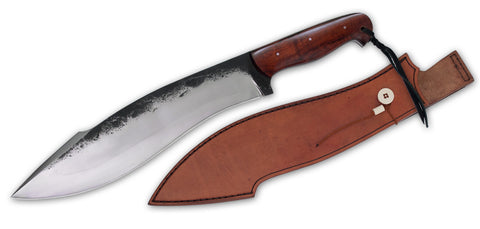
If you ask someone to describe a hunting knife, they’ll probably think of the classic camp knife. A camp knife has been designed to perform all of the tasks you’d expect a hunting knife to be capable off, they are great multi-purpose tools. amp knives are largely based on hunting knives, with the exception that they will generally have a larger drop point which is capable of performing a range of jobs around the camp site.
Bowie Knife
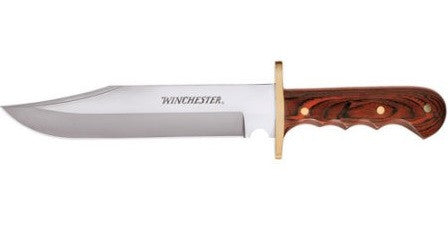
We’ve covered bowie knives fairly extensively in this article, but to recap, it’s a large fighting style of knife with a clip point that became widely adopted by hunters during the 19th and 20th centuries. You’ll find that many knives that are available are heavily influenced by the Bowie Knife.
Caping Knife

It’s extremely important to preserve the neck area of an animal if you wish to create an animal trophy. This where the caping knife excels, with its smaller size and upturned point, it’s the perfect utility for performing this delicate task. Even though a caping knife by definition specialises in caping, they can still be used to perform a variety of tasks.
Skinning Knife

A well designed skinning knife is an invaluable asset, at its heart it’s a tool that specialises in removing the skin from animals and, as such, it must include certain design properties, the most important of which is the correct design of the blade. Additionally, it needs to be sized correctly and needs to be capable of taking and holding an edge. Taking all of these points into consideration, choosing a well-designed skinning knife needs to take several factors into consideration.
Skinning Knife Blade Design
When deciding on a skinning knife, the design of the blade is one of the single most critical factors that needs to be taken into consideration. Even very small changes to a blade can impart a significant change to the way the blade handles. It’s important to be aware that the type of animal that’s being skinned will directly affect the methods and techniques used for removing the skin, this is due to the way the hides are attached to the muscle tissue. For example, all game within the deer family have hides that are loosely attached to the rest of the animal by way of a thin membrane. This membrane is easily sliced with a sharp knife, so it’s particularly well suited to knives that have a clip or drop point, as the tip can very easily penetrate and cut the membrane. However, an animal such as a wild boar will have a hide that is attached to the carcass by a layer of fat that is quite tough and fibrous when cut. In these circumstances a knife with a trailing point is particularly well suited to this sort of job, as the whole of cutting edge can be used to remove the hide with a sweeping cut.
Skinning Knife Blade Length
Blade length is an important aspect to consider when choosing a skinning knife. We strongly recommend matching the length of the blade to the size of the animal you intent to skin. For example, a small game animal such as a rabbit is best suited to a skinning knife with a small blade of around 8cm. A larger animal such as a deer may require a blade as large as 13cm, and so on.
Skinning Knife Blade Steel
A skinning knife which can take and hold an edge is a very important consideration. It can become very frustrating to stop and sharpen a knife when you’re halfway through a job. It is therefore critical that a skinning knife is made from very hard steel as opposed to durable steel, this is due to prioritising its ability to hold an edge over its ability to take punishment. We would recommend a knife of hardness between 56 HRC and 62 HRC in order to provide the best user experience. o further complicate the choice, you might have the option to pick between high carbon steel and stainless steels. For a skinning knife you’re better off picking a stainless steel blade, as long as it has sufficient hardness.
Skinning Knife Handle Design and Material
When picking out your skinning knife, I would suggest prioritising a handles ergonomic properties over aesthetic flair. Ideally you’ll want to pick a knife which is comfortable to hold at a variety of angles, edge up or edge down. Make sure the handle is suitable to your style of skinning, whether that’s with the index finger extended along the spine, or with the index finger wrapped around the handle, make sure it fits with your needs. Once you’ve met the usability and comfort requirements you can begin to look at the materials it’s made from, there’s no reason not to pick something decorative such as antler or horn if that’s what you prefer, skinning knives are rarely subjected to the same type of punishment as other hunting knives so they can afford to be pretty.
Fixed Blade or Folding Blade Skinning Knife
You’ll likely find that most experienced hunters prefer to use a fixed blade knife over a folding knife. It should be noted that when it comes down to functionality, there isn’t a definitive answer as to which is better and it largely comes down to personal preference.
Boning Knife
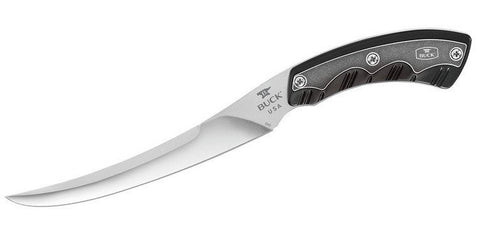
The boning knife is another type of specialised hunting knife which as the name suggests is used to debone carcasses. Before I begin to delve into the intricacies of the boning knife we should make sure we know what we mean when we talk about boning knives. If you already know and you’re very familiar with the topic, feel free to skip ahead into the next section. boning knife is most often used to remove the meat from the bone of an animal. It is not intended for cutting through bones, if you’re looking to cut bones then you might want to consider a cleaver.
You might not know this, but the boning knife is the most commonly used knife by butchers, it’s that important. A skilled butcher can use this type of blade to very carefully remove cuts of meat from an animal, leaving almost nothing behind but cartilage and bones. The boning knife can also be used on smaller animals and more intricate work, such as removing bones from a chicken breast or from a fish.
It’s additionally the perfect tool of choice for opening a cut of meat up for stuffing, cheese, spinach and garlic stuffed chicken breasts anyone?
Now that we’ve established what a boning knife is used for, you’re hopefully better able to decide if this is the sort of specialised hunting knife you’d like to add to your collection.
Boning Knife Blade
A boning knife should be kept sharp. Getting close to the bone with a blunt knife can be difficult and dangerous job, additionally force will need to be applied and can result in slipping and injury. Additionally, a dull blade will likely result in significant portions of meat to be left behind. Removing the meat from a carcass should be effortless and it shouldn’t require a workout. For this reason I would suggest honing your knife before every job and having your knives professionally sharpened once a year, alternatively you can follow our knife sharpening guide to do it yourself.
A Mid-Length Blade
You’ll want your blade to be long enough to slice through meat without requiring hacking, but you’ll also want the blade to be small enough the handle easily. For these reasons I would suggest buying a knife with a which is around 13cm long. Such a blade is perfect for slicing through meat and carcasses without effort while also allowing for good degree of control and finesse.
Heavy Handle
For most knives the weight ratio between the handle and blade should be even, however, this does not apply to boning knives. Since the boning knife is quite small it’s good practise to buy a knife whose handle is heavier than the blade. The heavier handle means you can have greater control the blade and can make movements and cuts more accurate. Finding a boning knife with a heavy handle should be relatively straightforward, the boning knife will traditionally have a think flexible blade means it’s weight is less than most similarly sized knife blades, as such the handle will often be heavier by default. If possible I would strongly recommend buying a boning knife which is full tang and
features a steel bolster and steel end cap.
Protective Pinch Bolster
A bolster is a piece which is added between the handle of the knife and blade. The bolster works to increase control and increase safety. As you use your boning knife on some particularly difficult jobs, with slippery slick fingers and excessive force, you’ll want to make sure fingers don’t slide off the handle onto the knife blade. While non-slip handles are pretty common place, they are no completely fail safe, but a protective bolster can help protect your fingers if your grip fails.
Flexible Steel Blade
Right off the bat we should rule out ceramic blades for use as a boning knife. Ceramic blades are inflexible, brittle and can easily snap, chip or shatter if they come into contact with bones. Never buy a ceramic boning knife! Since we’ve rules out ceramics, we’re left with steel as the obvious choice. It might seem obvious, but make sure you select a strong type of steel for your boning knife, I recommend carbon steel. Not only do you want a strong steel blade, but you’ll also want a flexible blade. Therefore, rather than defining the strength of the blade by it’s rigidity and impact resistance, it’s better to judge the blades strength by its ability to flex without snapping.
Buck Knife

A buck knife is a generic term for the knives made popular by Buck Knives. Specifically, it is any knife modelled after the Buck 110 Hunting Knife, which was a large folding hunting knife. These types of knives will most often have a clip point. Despite the origin as a hunting knife, the style of knife is very popular as a generic pocket knife.
Hunting Dagger

A hunting dagger is a knife which has been specifically designed to kill an animal. These knives are double edged with a sharp point and non-slip handle, they are designed to pierce the heart of the animal resulting in a quick death.
Hunting Knife Set
Even though the hunting knife set is not an actual type of knife, they are a great option for anyone looking to buy all the specialised hunting knives in one go. These knife sets will typically contain a caping knife, skinning knife, boning knife, butchers knife and more besides.
Additional Features of a Hunting Knife
Gut Hook
Most hunting knives comes with the option of buying them with a gut hook. A gut hook specialises in assisting the hunter in gutting the animal. The semi-circular sharpened hook which is normally located in the spin makes unzipping the skin of the animal somewhat easier, however, most capable hunters can already perform this task, so the value in a gut hook is debatable.
Blade Styles
The type of blade style comes down to personal preference, but there are largely three main types of blade points that you’ll likely encounter on a hunting knife, these are: Drop Point, Clip Point and Skinning Blade.
The clip point is a very popular feature on hunting knives, the design was popularised by the bowie knife and had proved to an excellent option for hunting knives. The clip point is characterised by a blade tip that has been partially clipped off, the tip is ideal for puncturing and making a slit, as such it is widely considered a great all round knife. Extra care must be taken with a clip point knife as it’s innate ability to penetrate skin means that it can inadvertently puncture a gut sack while dressing a kill in the field.
The drop point was popularised by Bob Loveless in his famous designs. The drop point follows the spine of the knife in a curved fashion which creates a lower point. This design offers more control for the wielder and increases the durability of the blade. The drop point is now the standard design for hunting knives.
Fixed or Folding Hunting Knives
A fixed blade hunting knife is not absolutely necessary, but it does offer several advantages over a folding knife. First and foremost, the lack of moving points and potential weak points mean a fixed blade knife is generally stronger and more reliable. Additionally, a fixed blade hunting knife is far easier to clean, with far fewer nooks and crannies for gunk and dirt to accumulate. On the flip side, a folding hunting knife will take up less space and can potentially contain several types of blades for various tasks.
Hand Guard
A great addition to any hunting knife is the hand guard. The very nature of the work performed with a hunting knife means they are prone to becoming very slippery and the last thing you want to happen is for your hand to inadvertently slip, giving yourself a nasty wound in the process. The hand guard prevents your hand from slipping onto the blade.
Ergonomics
It is absolutely essential that your hunting knife is comfortable and easy to use. Any knife which is difficult to hold or prone to slipping is asking for trouble. Prioritise comfort over aesthetics.
Serrated Hunting Knives
Serrated hunting knives are relatively uncommon, but they do exist. Unfortunately a serrated blade tends to hinder the functionality of a hunting knife rather than help.
Hunting Knife Sheath
Sheaths are not required for folding hunting knives, but they are absolutely essential for fixed blade knives. A sheath not only makes carrying a knife safe, they also protect the knife from the elements. I would personally recommend either leather or kydex for the sheath material.
source https://www.bladespro.co.uk/blogs/news/the-complete-guide-to-hunting-knives




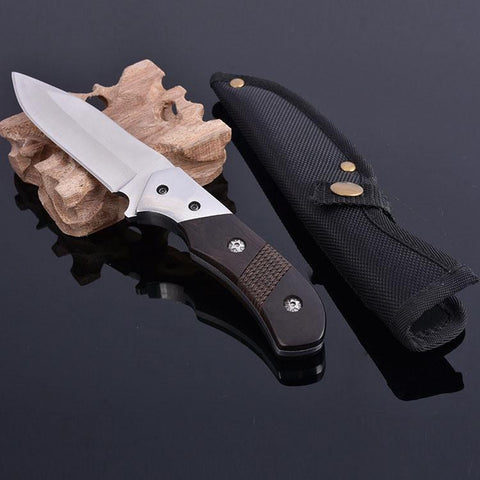
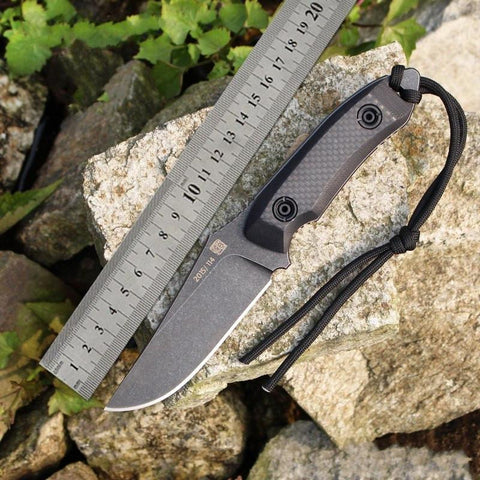
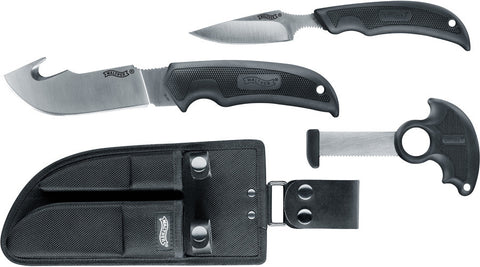
No comments:
Post a Comment